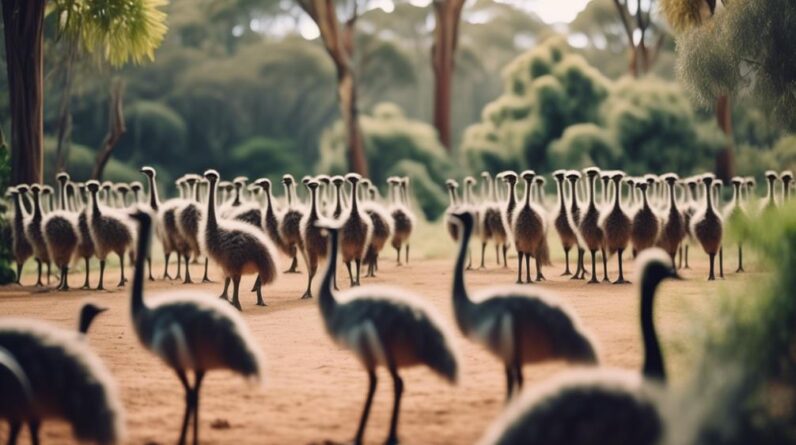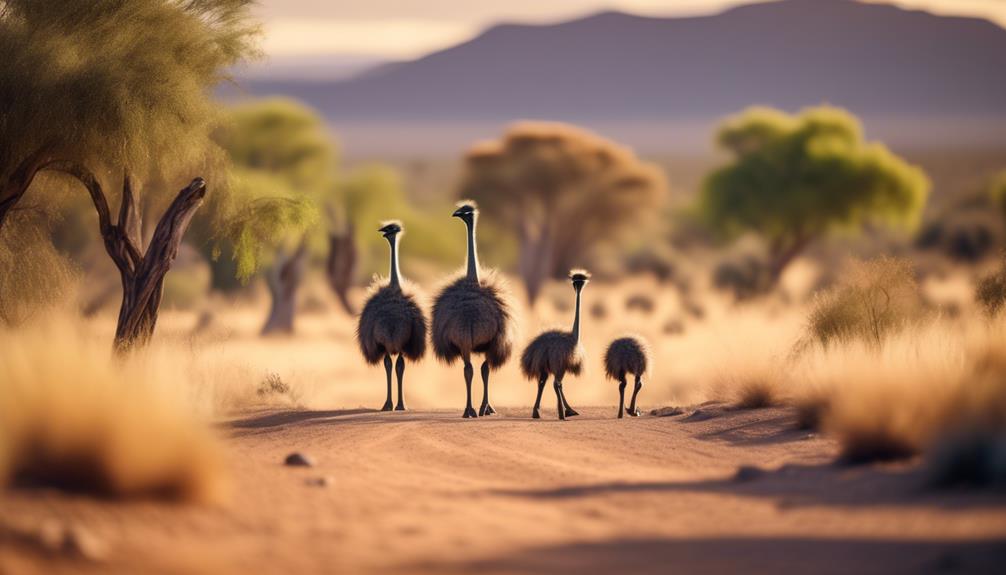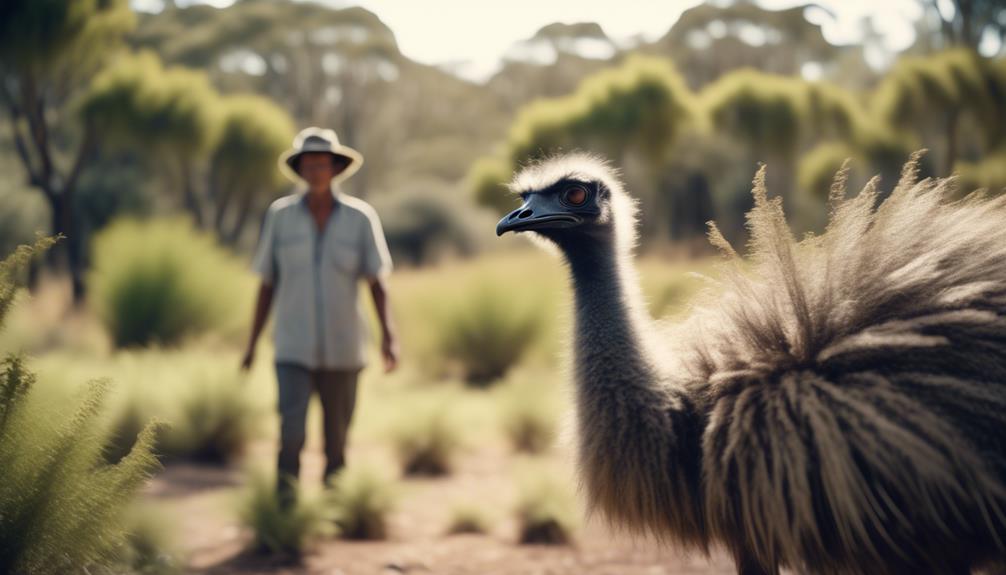
Like a majestic ostrich, the emu stands tall on the Australian plains, its unique appearance and curious nature captivating all who encounter it.
However, these remarkable birds face numerous threats to their survival, making their conservation efforts crucial.
In this discussion, you will explore the various initiatives and programs aimed at protecting emus, understand the importance of preserving their habitat, and discover how individuals like yourself can contribute to ensuring the future of these magnificent creatures.
Get ready to embark on a journey of discovery and learn how you can make a difference in the lives of emus.
Stay tuned for valuable insights and actionable steps that will leave you eager to play your part in preserving these incredible birds.
Threats to Emu Populations

Threats to Emu Populations include habitat loss, predation, and hunting. These factors have significantly impacted their numbers in recent years.
Emus, native to Australia, face the harsh reality of habitat destruction due to human activities. With the expansion of agriculture and urbanization, their natural habitats are being converted into farmlands and residential areas, leading to a loss of suitable breeding and foraging grounds.
Additionally, emus are vulnerable to predation by introduced species such as foxes and feral dogs. These predators pose a significant threat to emu chicks, which are particularly susceptible to predation due to their small size and limited mobility. The increased presence of these predators further exacerbates the decline in emu populations.
Furthermore, hunting and poaching pose a serious threat to emus. Although hunting emus is regulated in many countries, illegal poaching still occurs. Emu meat and eggs are highly sought after, both for their culinary value and for use in traditional medicines. The demand for these products contributes to the illegal trade and exploitation of emus.
Climate change also plays a role in the declining emu populations. The changing climate patterns, including extreme weather events and altered rainfall patterns, affect the availability of food and water sources for emus. These changes can disrupt their breeding cycles and reduce their chances of survival.
To protect emu populations, it's crucial to address these threats. Conservation efforts should focus on preserving and restoring their habitats, implementing effective predator control measures, and enforcing strict regulations to combat poaching. Additionally, monitoring and adapting to climate change impacts can help mitigate its effects on emus.
Conservation Initiatives and Programs
Conservation initiatives and programs have been implemented to address the challenges facing emu populations and safeguard their future survival. These efforts rely on community involvement and funding opportunities to make a significant impact.
One such initiative is the establishment of protected areas and reserves, where emus can thrive without disturbance from human activities. These areas provide essential habitats and ensure the birds have access to food, water, and shelter.
In addition to protected areas, conservation programs focus on research and monitoring to better understand emu behavior, population dynamics, and habitat requirements. This knowledge helps inform management strategies and conservation actions. For instance, researchers study emu breeding habits to identify potential threats to reproductive success and develop targeted conservation measures.
Community involvement plays a crucial role in emu conservation. Local communities are encouraged to participate in citizen science projects, such as reporting emu sightings and nesting activities. This information contributes to the understanding of emu distribution and helps identify areas that require conservation attention. Furthermore, community education and outreach programs raise awareness about the importance of preserving emu habitats and reducing human impacts.
Funding opportunities are essential to support conservation initiatives and programs. Governments, non-governmental organizations, and individuals can contribute financially to ensure the success of emu conservation efforts. Grants, sponsorships, and donations play a vital role in funding research, monitoring, habitat restoration, and community engagement activities.
Importance of Habitat Protection

Habitat protection plays a critical role in ensuring the long-term survival and well-being of emu populations. Biodiversity conservation strategies and ecological restoration efforts are essential for maintaining the natural habitats that emus rely on for food, shelter, and breeding.
One key aspect of habitat protection is the preservation of suitable vegetation. Emus are herbivores and depend on a diverse range of plants for sustenance. Protecting and restoring native vegetation helps to ensure that emus have access to the food sources they need to survive and reproduce.
Another important aspect of habitat protection is the safeguarding of breeding grounds. Emus construct large nests on the ground and carefully tend to their eggs. By maintaining undisturbed areas and protecting nesting sites, we can support successful reproduction and the growth of emu populations.
Additionally, habitat protection plays a significant role in preventing the fragmentation of emu habitats. Fragmentation occurs when habitats become broken up into smaller, isolated patches. This can lead to decreased genetic diversity, increased vulnerability to predators, and limited access to resources. By preserving and connecting intact habitats, we can enhance the resilience and long-term viability of emu populations.
Advocacy and Awareness Campaigns
To effectively promote emu conservation, it's crucial to engage in advocacy and awareness campaigns that educate the public about the importance of protecting these unique and fascinating birds.
Public education plays a vital role in raising awareness and understanding of the challenges facing emus and the need for their conservation. By reaching out to communities and individuals through various channels, such as social media, educational programs, and public events, we can inform people about the threats emus face and inspire them to take action.
Community involvement is also key in ensuring the success of emu conservation efforts. By actively engaging local communities, we can foster a sense of ownership and responsibility towards the protection of these birds. This can be achieved through organizing community workshops, volunteer programs, and citizen science initiatives, where individuals can contribute to monitoring and conserving emu populations in their respective areas.
Advocacy campaigns shouldn't only focus on the ecological significance of emus, but also highlight their cultural and historical importance. Emus hold a special place in the hearts and traditions of many indigenous communities, and recognizing this cultural connection can help build stronger support for their conservation.
Individual Actions for Emu Conservation

By incorporating simple yet impactful actions into your daily life, you can contribute to the conservation of emus and help ensure their survival for future generations.
One way you can make a difference is by supporting emu breeding programs. These programs aim to increase the population of emus in captivity and release them into the wild, thereby boosting their numbers and genetic diversity. You can participate in these efforts by donating to reputable organizations that specialize in emu conservation and breeding.
Another individual action you can take is community involvement. Engage with local conservation groups and join efforts to protect emu habitats. This can include participating in habitat restoration projects, volunteering for monitoring and research activities, and spreading awareness about the importance of preserving emu populations.
Additionally, you can contribute to emu conservation by reducing your ecological footprint. Emus rely on natural resources for survival, and by adopting sustainable practices such as conserving water, reducing energy consumption, and minimizing waste, you can help protect their habitats and ensure the availability of resources they need to thrive.
Frequently Asked Questions
What Is the Average Lifespan of an Emu in the Wild?
The average lifespan of an emu in the wild is about 10-20 years. Emu breeding patterns and population trends have a significant impact on their survival. Understanding and supporting these efforts can help protect these magnificent birds.
Are There Any Specific Diseases That Pose a Threat to Emu Populations?
There are several diseases that pose a threat to emu populations, such as avian influenza, Newcastle disease, and West Nile virus. These diseases can affect the health and survival of emus, making conservation efforts crucial.
Do Emus Migrate or Stay in One Area Throughout Their Lives?
Emus have complex migration patterns influenced by factors like food availability and breeding. They can move between different areas throughout their lives, adapting to changing conditions. Migration plays a crucial role in their survival and population dynamics.
How Do Conservation Initiatives Differ Between Different Regions Where Emus Are Found?
Conservation approaches for emus vary across regions. In Australia, government funding sources and research play a crucial role. In North America, private organizations and volunteer efforts are key. Each region's unique challenges require tailored strategies for success. Exciting, right?
Are There Any Specific Laws or Regulations in Place to Protect Emus From Illegal Trade or Hunting?
There are specific laws and regulations in place to protect emus from illegal trade and hunting. These include emu trade regulations and hunting laws for emus. These measures aim to safeguard the species and ensure their conservation.
Conclusion
By joining the emu conservation efforts, you become a guardian of hope for these majestic birds. Just as the emu's powerful strides symbolize resilience and determination, your actions can make a difference.
Protecting their habitat, supporting conservation programs, and spreading awareness are crucial steps towards securing a future where emus thrive.
Remember, every small effort adds up, and together, we can ensure the survival of these remarkable creatures for generations to come.





